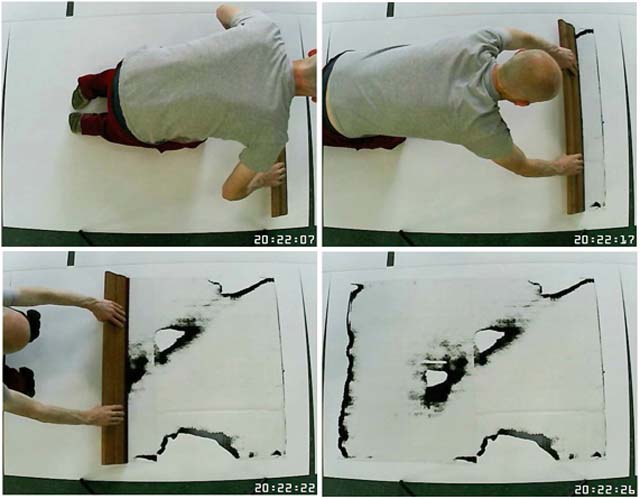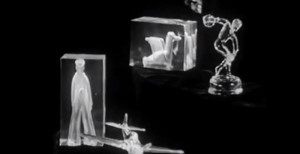Maurice Carlin’s Performance Publishing happens live, in front of an audience that can at anytime be made up of online spectators, selected writers, or visitors to a former furniture warehouse based in Salford, Greater Manchester. Slowly but surely the artist spreads CYMK paints, associated with the colours used in newspaper printing, with a weggee, across thick pieces of paper, laid out on an industrial floor. Peppered with characterful cracks and pale colours, the prints bring to mind Abstract Expressionism in their aesthetic but in truth are a very real documentation of the space in which they were created. Side by side, mapped out across the huge floor, they make up a pattern across the space, which reveals subtle variation, as well as the possibilities such a space can offer an artist.
Travelling into Salford, the site of derelict buildings meets you head on. And it’s inevitable that the context of the performance, in the sense of the scale of the area to work in at the Regent Trading Estate, will play on the mind. Far from the extortionate rents of London, where artists cram into tight spaces, building in floors to accommodate their friends or bedrooms, room for expansive projects is a possibility. Yet, at the same time, this is a totally connected project, accessible from around the world, with a live feedback channel, that gives spectators a chance to comment on the process of production in front of their eyes. In response, Carlin shapes the layout of the work into a triangular ‘v’ that matches the perspective of one of the camera views, while the other peers over his shoulder as he works.

Having already worked on a project titled The Self-Publisher, gathering refuse photocopying from various shops in different cities, stapling them into ready-made zines full of anecdotes, such as exercise routines or CVs, this project carries on that idea of gathering locally-sourced information. It’s a basic publishing production technique but, most importantly for Carlin, it’s also a moment when there is a literal transfer of information.
In ‘Screenscans Havana 14’30’ (2012) Carlin switches on a handheld scanner before moving it slowly back-and-forth over the charged surface of a television screen. The work then produces a single-angled, black and white storyboard, crashing narratives from various channels across the screen, and flattening them into one continuous glitch. In short, Carlin takes an interest in the importance of surfaces, the mechanisms that produce those surfaces, and the way in which we interact with them. In his own work he pushes all of these to the extreme. One of his simplest and most effective demonstrations of this is creating relief prints off street walks for on-looking passers-by.
In Performance Publishing, printing, production and distribution all happen at once. A very close interaction with one surface becomes captured information, disseminated to a global audience, across screens and the artist is brought to life as the medium through which an audience interacts with one and the other.**
Header image: Steve Iles
















